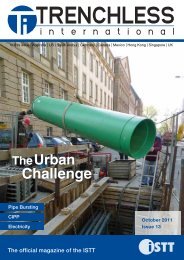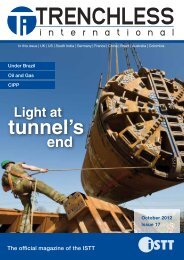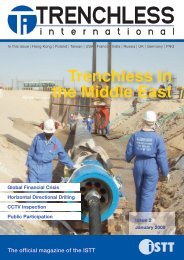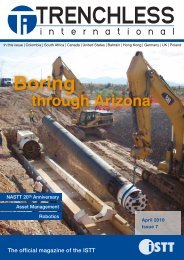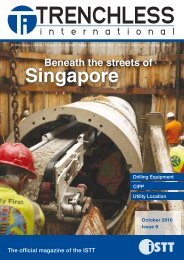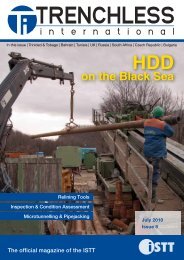North American Special - Trenchless International
North American Special - Trenchless International
North American Special - Trenchless International
Create successful ePaper yourself
Turn your PDF publications into a flip-book with our unique Google optimized e-Paper software.
north america<br />
is a biaxial stress, which is a combination<br />
of hoop stress due to internal pressure<br />
and longitudinal stress due to bending<br />
of the pipe to achieve the curved shape<br />
of the HDD path added to the stress<br />
imposed on the pipeline due to thermal<br />
differential. A large positive thermal differential,<br />
together with internal pressure<br />
is typically the worst case.<br />
Shortly after deciding to complete<br />
the 36 inch ream the project team recognised<br />
it may not be reasonable to<br />
expect the 36 inch ream, to improve the<br />
current minimum pilot hole radius from<br />
270 metres to the minimum calculated<br />
radius of 425 metres as calculated in<br />
the Tresca analysis. This led to another<br />
refinement of the combined stress calculation.<br />
A more realistic approach is to<br />
compute combined stress as per the Von<br />
Mises formula, which uses similar inputs<br />
as Tresca with modest time and effort<br />
required. The Von Mises calculation<br />
method is also known to be more realistic<br />
for ductile steel such as employed in<br />
modern oil and gas pipeline systems.<br />
For the Pine Creek crossing the soil<br />
within the drill path was assumed to<br />
be a ‘soft formation’ based on feedback<br />
from the drilling contractor, the<br />
difficulty experienced with down hole<br />
steering and the results of the geotechnical<br />
investigation carried out by AMEC<br />
Earth and Environmental. This resulted<br />
in the use of soil category A.<br />
Analysis of the drill path was completed<br />
using the Von Mises method<br />
with the above parameters. The resultant<br />
minimum acceptable radius was<br />
determined to be 385 metres, a marginal<br />
improvement on the previous<br />
425 metres. The 385 metre radius would<br />
need to be compared to the calculated<br />
minimum radius in the drill path after<br />
completion of the 36 inch ream.<br />
The ream was completed two days<br />
later. Entec analysed the drill profile<br />
data and calculated a minimum dogleg<br />
radius of 284 metres, with a number<br />
of other radii less than 385 metres.<br />
The subsequent survey tool run was<br />
completed later in the same day. Entec<br />
analysed these results and calculated<br />
a minimum radius of 170 metres<br />
with a number of other radii less than<br />
385 metres. The ever decreasing calculated<br />
minimum radius confirms that the<br />
progression of the calculations is from<br />
conservative to more realistic.<br />
Pembina and its construction manager<br />
subsequently decided to pull the NPS24<br />
pipe, as seen on page 55, into the hole<br />
and the project team agreed to continue<br />
analysing the available information to<br />
determine if in fact the 36 inch reamed<br />
drill path was acceptable.<br />
First, the project team completed a<br />
sensitivity analysis to determine if reducing<br />
the MOP of the pipeline or increasing<br />
the pipe grade would be a viable alternative.<br />
After careful review, the required<br />
MOP reduction to 4,400 kPa or pipe<br />
grade increase to 545 MPa were still not<br />
sufficient to provide acceptability for the<br />
Pine Creek crossing.<br />
The next and only viable alternative<br />
for analysing the crossing was to determine<br />
the absolute stress level within<br />
the pipe at this location. The Tresca<br />
and Von Mises methods are both stress<br />
based, conservatively not accounting<br />
for the nonlinear steel properties. Due<br />
to tight bend radii determined in the<br />
field, the group agreed to undertake a<br />
third method of analysis; a nonlinear<br />
strain analysis, which is permitted by<br />
CSA-Z662 Annex C as a limit states<br />
design approach. This strain analysis is<br />
much more complex than either stress<br />
method, but it also is a more rational<br />
and usually less restrictive approach.<br />
Determination of the longitudinal strain<br />
with nonlinear steel properties and subject<br />
to biaxial stresses is performed with<br />
a finite-element computer program.<br />
Subsequent to the very detailed review<br />
of the stresses involved in this installation,<br />
the current drill alignment was<br />
supported by Worley Parsons Calgary,<br />
based on the maximum calculated strain<br />
being below the maximum allowable<br />
strain for the crossing using limit states<br />
analysis. Colt used the minimum drill<br />
path radius of 170 metres and compared<br />
the strain at this location to the maximum<br />
strain allowable for the NPS24 crossing<br />
pipe. The results were deemed acceptable<br />
as per the above discussion.<br />
In addition, Colt has recommended<br />
running a geo-pig through the crossing<br />
within two years of the start of pipeline<br />
operation. This can be used to verify the<br />
geometry of the pipe within the crossing<br />
and reconfirm the results of the limit<br />
states analysis. It is anticipated that the<br />
final geometry of the drill profile will be<br />
better than the lowest indicated radius<br />
of 172 metres.<br />
The purpose of this article is not to<br />
support less conservative analysis as<br />
a general rule for HDD installations but<br />
rather, given the difficult circumstances<br />
encountered at the site, to illustrate that<br />
this method of analysis is applicable and<br />
required in certain circumstances. HDD<br />
installations of pipelines beneath pipeline<br />
route obstructions are technically<br />
challenging, as are the determination of<br />
the construction stresses. These installations<br />
are such that future repair and<br />
cleanup if a problem develops, are<br />
not possible or are extremely difficult<br />
due to the location and depth of these<br />
installations. Therefore, a conservative<br />
approach to the design provides some<br />
assurance that problems should not<br />
occur at this type of crossing.<br />
This article is an edited version of a paper entitled<br />
Does the HDD reaming pass remove extreme<br />
alignment dog-legs: Case History by James P.<br />
Murphy, Glen Fyfe, Trevor Giesbrecht and Wes<br />
Dyck. The paper is to be presented at No-Dig<br />
2009 Toronto, Canada. Please refer to the paper<br />
for references and acknowledgements.<br />
Below: Crossing Alignment at Pine<br />
Creek- ROW sandwiched between<br />
adjacent ROWs.<br />
Rehabilitating New<br />
York City’s NCA<br />
By A Noble, D Roberts and A Fareth<br />
Constructed between 1885 and 1891, the New Croton Aqueduct<br />
(NCA) in New York State is a 50 km tunnel conveying water from<br />
the Croton watershed north of New York City to distribution<br />
systems in the Bronx and Manhattan. The NCA has benefited from<br />
an extensive design, inspection and rehabilitation program.<br />
The NCA rehabilitation program<br />
has been underway in phases since 1993,<br />
with inspections scheduled to minimise<br />
outages, allowing this strategic aqueduct<br />
to remain in service during critical seasonal<br />
periods. Between 1993 and 1997<br />
a series of in-tunnel investigations were<br />
performed in the open channel portion of<br />
the NCA, consisting of field inspection,<br />
non-destructive geophysical testing, and<br />
coring of the brick liner.<br />
Between November 2004 and<br />
September 2005, a major inspection<br />
program was conducted to assess the<br />
condition of the 11 km long pressurised<br />
section and all shafts, headhouses and<br />
blow-off structures along the entire 50 km<br />
alignment. Inspection methods included<br />
using an underwater remote operated<br />
vehicle (ROV) equipped with sonar and<br />
cameras to inspect the deep siphon, fibre<br />
optics examinations of probe holes drilled<br />
through and beyond the brick lining, and<br />
core holes and geophysical inspections to<br />
assess properties of the liner and behindthe-liner<br />
materials. A water pressure and<br />
test grouting program was conducted<br />
to assess methods and expected grout<br />
takes for the rehabilitation work in the<br />
pressurised sections. The rehabilitation<br />
program is anticipated to be completed<br />
in 2010.<br />
Part 1: planning and design<br />
The overall concept for rehabilitation<br />
of the NCA was developed in the early<br />
1990s, at which time a far-reaching program<br />
for achieving a logical and practical<br />
approach to the work was established.<br />
Since outages could only take place seasonally,<br />
contracts for any program had to<br />
be appropriately sized to coincide with<br />
the seasonal outages, while taking into<br />
account the operational needs of other<br />
water supply aqueducts owned and operated<br />
by NYCDEP.<br />
The design for the NCA rehabilitation<br />
was initially based on the results of previous<br />
investigations performed within the<br />
aqueduct’s gravity flow section in 1993<br />
and 1996. The field investigation program<br />
in 1993 included:<br />
• Visual inspection of 9.6 km of tunnel<br />
• Geophysical surveys of 9.6 km of tunnel<br />
• Remote operated vehicle (ROV) inspections<br />
• Gould’s Swamp siphon<br />
• Harlem River siphon<br />
• Probe and core drilling<br />
• Fibre optic scope inspection.<br />
The field investigation program in 1996<br />
included:<br />
• Visual inspection of the remaining 29<br />
km of gravity flow tunnel<br />
north america<br />
April 2009 - <strong>Trenchless</strong> <strong>International</strong><br />
The NCA is a 3.73 to 4.34 metre diameter, brick-lined circular, and horseshoe-shaped water tunnel.<br />
Except at two siphons, the aqueduct operates as an open channel conduit from the New Croton Reservoir<br />
downstream 39 km to the Jerome Park Reservoir in the Bronx. The remaining 11 km is operated as a<br />
pressurised conduit and includes a major siphon, of circular cross-section, under the Harlem River. A total of<br />
163 million bricks were used in the construction, enough to build a 48 km wall around Manhattan Island,<br />
3 metres thick and 15 metres high.<br />
The aqueduct has a flow capacity of approximately 1,100 million litres of water per and supplies on average<br />
ten per cent of New York City’s drinking water. The City’s water supply system is operated and maintained<br />
by the New York City Department of Environmental Protection (NYCDEP). Until a partial inspection in 1982,<br />
the NCA had flowed continuously since its completion nearly 100 years before. Flow tests have confirmed<br />
that the NCA can convey up to 290 million gallons per day.<br />
April 2009 - <strong>Trenchless</strong> <strong>International</strong><br />
56<br />
57






